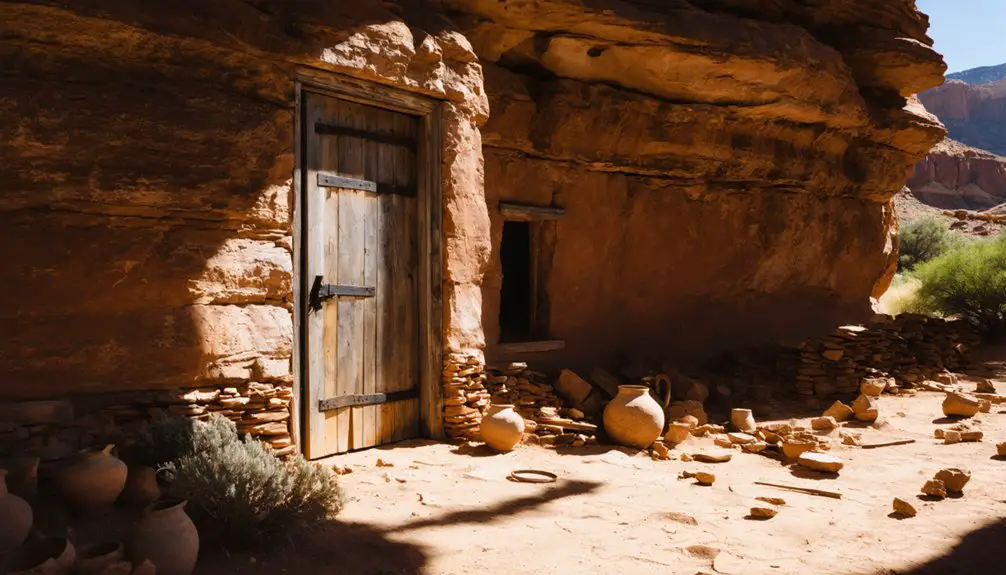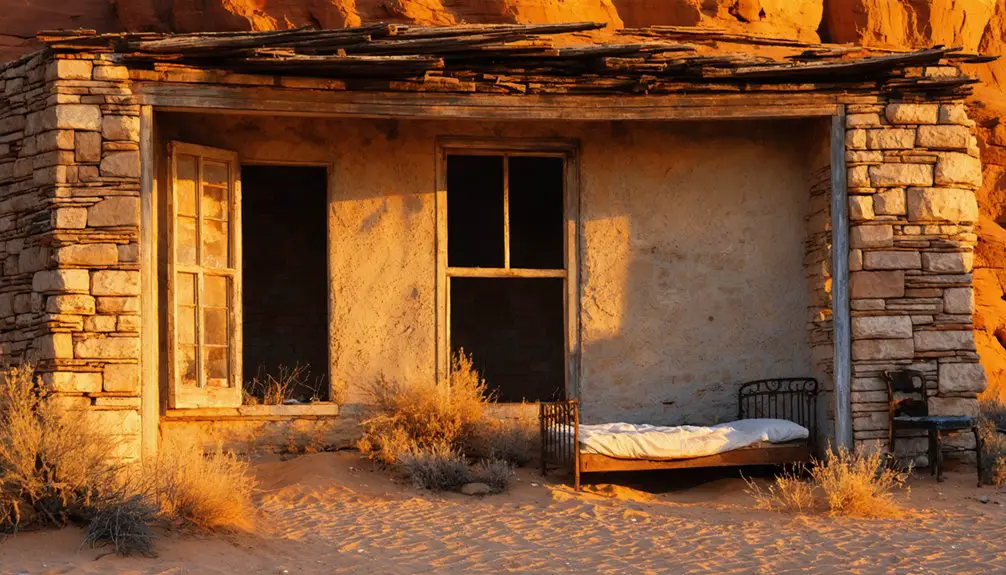You’ll find Harrisburg Ghost Town‘s stone ruins along Old Highway 91 between Leeds and St. George, Utah. Founded in 1859 by Moses Harris, this pioneer settlement grew to 200 residents by 1868 before nature’s fury took its toll. Floods, grasshopper plagues, and Native American raids eventually forced settlers to abandon the town by 1895. Today, you can explore the restored 1864 Orson Adams House and weathered sandstone structures that tell a compelling frontier story.
Key Takeaways
- Harrisburg was established in 1859 by Moses Harris near Quail Creek, becoming one of Southern Utah’s earliest pioneer settlements.
- The ghost town contains preserved stone ruins, including the restored 1864 Orson Adams House and historic pioneer cemetery.
- Located between Leeds and St. George along Old Highway 91, the site is accessible and approximately 20 minutes from St. George.
- The settlement was abandoned by 1895 due to floods, poor farming conditions, grasshopper plagues, and Native American raids.
- Original stone foundations, roofless structures, and historic irrigation systems remain visible among modern residential developments.
The Birth of a Pioneer Settlement
When Moses Harris established Harrisville in 1859 near the mouth of Quail Creek, he laid the foundation for one of Southern Utah’s earliest pioneer settlements.
Pioneering the frontier, Moses Harris founded Harrisville in 1859, marking a historic chapter in Southern Utah’s early settlement.
Harris, who’d previously been involved with Mormon colonies near San Bernardino, led several families to this promising location along the Virgin River, driven by pioneer motivations to build a self-sustaining community. Like the Native Americans who inhabited Pennsylvania territories as far back as 3000 BC, these settlers sought to make the most of the land’s natural resources.
The settlers faced immediate settlement challenges as they worked to tame the rugged landscape. They constructed buildings from local stone, marked their boundaries with stone fences, and built a school using cedar materials. By 1868, twenty-five families had established homes in the fertile valley.
You’ll find their determination reflected in the ambitious 5-mile irrigation canal they engineered along Leeds Creek to support their agricultural endeavors.
However, nature had other plans – the 1862 floods forced them to relocate, and they renamed their community Harrisburg in honor of their founder.
Early Years Along the Virgin River
After relocating to higher ground following the 1862 floods, Harrisburg’s pioneer community flourished along the Virgin River, growing from sixteen families to roughly 200 residents by 1868.
You’ll find the pioneer lifestyle reflected in their resourceful use of local materials, as they built sturdy stone houses and barns from rocks cleared from their farmland. Despite challenges, the settlers constructed stone buildings that demonstrated their adaptability to available resources.
Early agriculture proved challenging, with settlers facing devastating grasshopper plagues that threatened their food security. They adapted by constructing miles of stone fences to protect their crops and mark property boundaries. The community suffered additional hardships from frequent Indian raids.
The Orson Adams House, built in 1864, stands as a symbol of their resilient spirit, featuring two rooms of carefully crafted stonework.
The settlement became a crucial waypoint for travelers heading to nearby silver mines.
Natural Disasters and Community Struggles
Throughout its troubled existence, Harrisburg faced a relentless series of natural disasters and social challenges that ultimately led to its demise.
You’ll find that flood impacts first struck in 1862, forcing residents to relocate the settlement from Harrisville to higher ground along Quail Creek, where they renamed it Harrisburg. The town’s historic sandstone houses still stand today as reminders of the original settlement. Today, the ruins sit just 14 miles northeast of St. George along Old Highway 91.
The community’s struggles intensified as Native American raids disrupted daily life, while devastating grasshopper plagues triggered agricultural decline.
Persistent Native American raids and devastating grasshopper infestations crippled the community, shattering its farming economy and peaceful existence.
These challenges created a perfect storm of hardship that steadily eroded the town’s population. By 1868, about 200 people called Harrisburg home, but recurring floods and crop failures drove many to seek refuge in nearby Leeds and Silver Reef.
The combination of these persistent threats proved too much, and by 1895, you’d find nothing but an abandoned ghost town.
From Thriving Town to Abandonment
Despite its promising beginnings in 1859, Harrisburg’s trajectory from a flourishing settlement to abandonment unfolds as a stark reflection of pioneer-era challenges.
You’ll find the town’s population shifts followed a clear pattern: growing to 128 residents by 1864 and peaking near 200 by 1868, before beginning a steady decline in 1869.
Environmental impacts dealt successive blows to the community’s sustainability – from devastating floods that forced relocation to rocky soil that limited farming potential. The town was originally named Cottonwood Creek due to the waterway that flowed nearby.
When grasshoppers decimated crops in the late 1860s, it proved a turning point. Coupled with persistent Native American raids and the town’s isolation, these hardships pushed residents to seek better opportunities in Leeds and Silver Reef. The town, originally established by Moses Harris and Mormon families in 1861, eventually succumbed to these mounting pressures.
Historical Remnants and Modern Development
If you visit Harrisburg today, you’ll find several pioneer-era stone buildings still standing, including the restored 1864 Orson Adams House now managed by the Bureau of Land Management.
The historic cemetery remains visible within the ghost town area, preserving the memory of early settlers who lived and died in this once-thriving community.
Modern development has integrated with these historical remnants, as Interstate 15 now bisects the original townsite and the Harrisburg Estates residential development encompasses portions of the former pioneer settlement.
The town faced numerous challenges in its early years, including devastating Virgin River floods that ultimately contributed to its abandonment by 1895.
Pioneer Buildings Still Standing
Several pioneer-era stone buildings stand as proof to Harrisburg’s early settlement, with the most prominent being the 1864 Orson Adams House.
You’ll find remarkable stone preservation throughout the site, showcasing the architectural significance of Mormon pioneer construction techniques. Much like other heritage tourism sites across America, these preserved structures now attract visitors interested in learning about frontier life.
- The Orson Adams House remains the most intact structure, featuring two rooms with thick stone walls that provided natural insulation year-round.
- Multiple stone houses and foundations cluster near Interstate 15’s east side, now part of an RV camp.
- Original stone foundations mark the footprints of pioneer homes across the townsite, built to withstand floods and grasshopper plagues.
- The Bureau of Land Management’s 2001 acquisition and restoration of the Adams House guarantees this evidence of pioneer craftsmanship will endure for future generations to explore.
Cemetery and Historic Markers
Beyond the stone buildings, the historic Harrisburg Cemetery stands as a poignant tribute to the town’s pioneer legacy at 5800 North Old Highway 91.
You’ll find it nestled within Harrisburg Estates at 3,079 feet elevation, enclosed by an iron fence that marks this sacred ground.
The cemetery’s preservation tells the story of Harrisburg’s 1859-1895 pioneer era, where settlers faced floods, raids, and plagues.
Through genealogical research efforts like Find A Grave and Washington County tombstone projects, you can trace the lives of those interred here – half of whom were children under six, reflecting the harsh realities of frontier life.
Today, while modern homes surround this historic site, the cemetery remains protected, offering you a tangible connection to Utah’s pioneering past.
Modern Residential Integration
Through extensive modern development, Harrisburg’s historic remnants now blend with contemporary residential life in an area known as Harrisburg Estates.
The site’s transformation balances historic preservation with modern amenities, while Interstate 15 bisects the original townsite.
You’ll find carefully integrated historical features throughout the development:
- The restored 1864 Orson Adams House serves as a centerpiece of community engagement and pioneer heritage.
- Original stone foundations and roofless structures remain preserved among new homes.
- Historic irrigation systems and water management structures coexist with residential properties.
- A one-lane road beneath I-15 connects modern developments to original town ruins.
Despite modern infrastructure‘s dominance, you can still access many historic sites, though some require permission through the RV camp on the east side of the interstate.
Dinosaur Discoveries and Natural Heritage

The Cleveland-Lloyd Dinosaur Quarry stands as the crown jewel of local dinosaur fossils, preserving over 70 individual specimens.
You can explore trace fossils along the Silver Reef and Red Reef East Trails, where footprints from Grallator, Eubrontes, and Kayentapus groups tell stories of ancient movement patterns.
The Morrison Formation‘s perfect preservation conditions have secured Harrisburg’s place in paleontological history.
Visiting the Ghost Town Today
Located on Old Highway 91 between Leeds and St. George, Utah, Harrisburg’s stone ruins await your ghost town exploration.
Venture into Utah’s forgotten past as Harrisburg’s weathered stone ruins beckon explorers along historic Old Highway 91.
You’ll find this historic site just 20 minutes from St. George, nestled within Hurricane’s legal boundaries. The abandoned settlement offers unrestricted access to photographers and history enthusiasts, with several pioneer structures still standing as silent witnesses to the past.
- Visit the original stone houses and foundations scattered throughout the site
- Explore the historic cemetery and remnants of the old blacksmith shop
- Discover prime photography opportunities among the weathered sandstone structures
- Access nearby hiking trails, including Silver Reef and Red Reef East, for expanded adventure
Remember to bring water and supplies, as no services exist on-site.
While exploring freely among the ruins, exercise caution with deteriorating structures and respect the site’s historical significance.
Frequently Asked Questions
Are There Any Reported Ghost Sightings or Paranormal Activity in Harrisburg?
You won’t find documented ghost stories or paranormal investigations here. Despite being called a ghost town, there’s no credible evidence of supernatural activity – it’s just historically abandoned ruins.
What Happened to Moses Harris After the Town Was Abandoned?
You won’t find clear records of Moses Harris after Harrisburg’s abandonment. His legacy lives on through the town he founded, but his fate remains a mystery in Washington County’s historical records.
How Many Original Pioneer Families Still Have Descendants in the Area?
You’ll find 10-15 pioneer lineages still represented in the area today, with these family histories maintained through descendant societies and local heritage organizations that preserve their ancestral connections.
Were Any Valuable Artifacts or Treasures Found in the Abandoned Ruins?
While you won’t find gold treasures, artifact discoveries revealed something equally valuable: Chinese currency, porcelain bowls, and cultural items that tell forgotten stories of early Chinese residents’ daily lives.
Did Any Native American Tribes Have Settlements in Harrisburg Before Pioneers Arrived?
While there’s no direct evidence of permanent Native settlements at this specific location, you’ll find that Ute and related tribes frequently moved through the area for seasonal activities and resource gathering.
References
- https://en.wikipedia.org/wiki/Harrisburg
- https://hikestgeorge.com/harrisburg-ghost-town/
- https://www.onlineutah.com/harrisburghistory.shtml
- https://www.houseofhighways.com/usa/west/utah/harrisburg
- https://www.islands.com/1946399/abandoned-ghost-town-utah-mountains-harrisburg-utah-hours-las-vegas-red-rock/
- https://jacobbarlow.com/2014/06/07/harrisburg/
- https://wchsutah.org/towns/leeds-sign1.pdf
- https://abbeyinncedar.com/1896/
- http://www.ghosttownaz.info/harrisburg.php
- https://jacobbarlow.com/2023/02/02/harrisburg-2/



